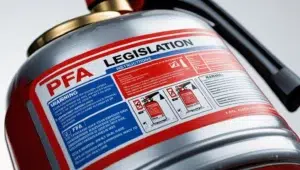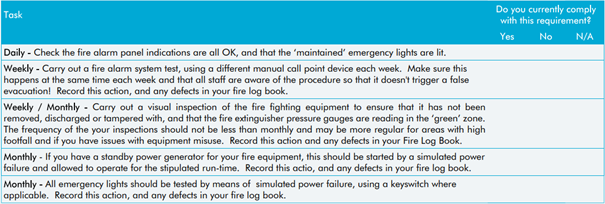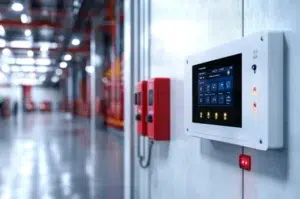
PFA Legislation – Foam fire extinguishers
Only foam extinguishers containing PFOA are banned. Many foam extinguishers manufactured post2016 are already PFOA-free, or contain alternative PFAS like C6, which are still legal.
Book your FREE, no-strings-attached Fire Safety Audit to ensure that you’re properly protected from the risk and comply with current fire safety legislation.
Get essential insights and updates
in fire safety – straight to your inbox!
We’ve created this guide of the ‘Top Ten Fire Safety Action Points for Schools’ to help you stay safe and avoid legal issues. If you’re in charge of fire safety at your school, this checklist gives you easy-to-follow steps. Our guide focuses on keeping students and staff safe in schools. It’s about more than just following rules; it’s about keeping everyone safe. As the ‘Responsible Person,’ it’s important to do more than just meet legal requirements – it’s about keeping yourself safe too.
WHO IS YOUR RESPONSIBLE PERSON ONSITE? IS IT YOU? MAKE SURE THEY ARE AWARE OF THEIR DUTIES AND RESPONSIBILITIES
Fire safety legislation (the Regulatory Reform Order (RRO), 2005) states that one person must be responsible for fire safety on site. This person may have subordinate persons with clearly delegated responsibilities, but they remain responsible for the overall control of fire safety on site.
It’s essential to have a designated Fire Safety Manager to ensure accountability and consistency of approach. This person will usually be a senior staff member, such as the Head Teacher or the Deputy Head Teacher. On larger facilities, a dedicated person (e.g., an H&S Manager) may be appointed to this role.
SOME NOTES CONCERNING RESPONSIBILITIES AT SCHOOLS
THIS DOCUMENT IS CRITICAL TO COMPLYING WITH THE LAW
Every organization must have an up-to-date fire risk assessment (FRA) covering all facets of fire safety onsite. It is an important document that your insurers, a fire officer, or a court of law could ask to see at any point. You can carry out your own FRA if you are sufficiently ‘competent’. Alternatively, you may prefer to contract a specialist Fire Risk Assessor who can conduct the FRA on your behalf.
The 5-Step Procedure for Conducting an FRA:
“A competent person is someone with enough training and experience or knowledge and other qualities to be able to complete their duties properly.”
THE EVACUATION IS THE MOST IMPORTANT PART OF YOUR FIRE PLAN. DO YOUR STAFF HAVE THE TRAINING TO RESPOND CORRECTLY IN A FIRE?
At any premises, particularly schools, the safe and swift evacuation of the building in the event of a fire alarm activation is essential. It would be best to have a detailed ‘Fire Evacuation Plan’ that all your team members know and understand their responsibilities in an emergency.
“When a fire happens, time is crucial. Your team needs to react instinctively. Practice with regular fire drills to build that instinct. Keep track of all drills and suggestions in your fire log book.”
CHILD PROTECTION AND SAFEGUARDING DURING FIRE EVACUATIONS
The new child safeguarding policies (Keeping Children Safe in Education, 2016) affect almost every aspect of caring for the pupils onsite. You must work with your safeguarding officer to ensure that your evacuation plan considers these unique circumstances and that your strategy does not have any loopholes.
Consider the following points which are easy to overlook:
ARE THERE PEOPLE ONSITE THAT MAY NEED HELP IN AN EVACUATION?
The Equality Act (2010) states that if disabled people could realistically expect to use your premises, you must anticipate any reasonable adjustments that would make it easier to exercise that right. This extends to your Fire Safety Policy.
If disabled people are going to be on your premises, you must also provide a safe means for them to leave if there is a fire. As disabled persons may not react (or be able to respond) or can react differently to a fire warning or a fire, you may need to create a PEEP (Personal Emergency Evacuation Plan) for them to ensure that they are given the support they need in the event of a fire.
Consider these points when working on your strategy:
FIRE DOORS ARE PROBABLY THE MOST COMMON, YET ONE OF THE MOST CRITICAL BREACHES OF FIRE SAFETY STANDARDS AT SCHOOLS.
Fire doors are designed to save lives by stopping the spread of fire and smoke, allowing your staff and students time to escape. However, missing smoke seals, blocked doors, damaged hinges, and faulty closers are issues we encounter every day and can render your fire door useless.
In a high-traffic environment like a school, proactive and regular fire door checks are essential to ensure your building is safe. You also need to ensure that your passive fire protection measures, such as fire breaks and containment walls, are suitable. The best fire door is virtually useless if the ceiling void above it is breached, allowing smoke and flames to pass through.
To request your free fire door inspection checklist – email andrew@blazequel.com with ‘Fire Door Inspection Form’ in the subject line.
If you’re unsure whether your passive fire protection meets standards, consider a professional inspection. This is a specialist technical area.
AROUND 50% OF ALL SCHOOL-TIME FIRES ARE CAUSED BY ARSON
In 2001, the cost to the UK of arson attacks at schools and educational facilities was estimated to be over £115 million. Even more concerning is the potential impact on the quality of the student’s education if a facility with all its learning resources and years of work is destroyed.
Proactive housekeeping and student education are the best ways to tackle this risk and keep your facility and those within it safe from this threat.
FALSE ALARMS CAN CAUSE COMPLACENCY AND WASTE VALUABLE TIME IN AN EVACUATION, WHICH RISKS LIVES NEEDLESSLY.
Malicious or accidental damage can cause false alarms, which, within seconds, will initiate the evacuation of your entire school building! A typical evacuation can cost £100’s in wasted teaching time, strain the fire service’s time and resources, and possibly land you a bill to repair your fire alarm system!
Consider the following points to help prevent equipment misuse or damage:
ACCURATE RECORD-KEEPING IS ESSENTIAL AS PROOF OF COMPLIANCE
All your fire safety procedures should be recorded in a fire log book as proof of compliance with the Regulatory Reform (Fire Safety) Order, 2005. During a fire or fire safety inspection, your insurers, the fire service or a court of law may request to see your fire log book.
Your fire logbook should be available near the building entrance so that the fire service can easily access it in the event of a fire. Any site plans, fire evacuation strategies, and risk assessments should also be available to ensure that they have the information they need to swiftly understand the risks on site and react accordingly without delay.
5 TOP TIPS
A QUICK SELF-AUDIT TO HELP YOU ENSURE THAT YOU’RE COMPLIANT
There are many different things you need to check onsite on a daily, weekly, and monthly basis to ensure your fire protection equipment is all in good working order. Leaving your fire protection for the 3-6 monthly visits by the fire safety maintenance engineer isn’t an option!
Complete this checklist to ensure you fulfil your duties onsite for the most common equipment!

THINK – Do you have any other fire equipment onsite? Should this be check as well?
…Constantly Review Your Fire Safety
DON’T REST ON YOUR LAURELS – THERE’S ALWAYS WAYS TO IMPROVE!
If you are meeting all of the points raised in this document, that is fantastic – give yourself a big pat on the back because you’ve taken some necessary steps towards keeping yourself, your colleagues, and your students safe from the risk of fire!
However, things change, and you should continually review your fire safety policies to ensure you keep up with changes at your school and technological advances that could improve your safety.
Some points to consider are:
Schools can maintain a safe learning environment by following these top ten fire safety actions and utilizing resources.
If you have any questions while reading this guide, please speak to one of our experienced advisors or email us. We will be glad to help!

Only foam extinguishers containing PFOA are banned. Many foam extinguishers manufactured post2016 are already PFOA-free, or contain alternative PFAS like C6, which are still legal.

Fire alarm monitoring in the UK is facing major changes due to the phase-out of traditional communication networks and providers. Analogue phone lines (PSTN) are being switched off by December

In industrial environments, safety is more than a priority—it’s a responsibility. Yet, one of the most dangerous threats to worker health is often invisible, odorless, and too often overlooked: carbon
Video Smoke Detection is perfect for a fast response to fires in high roofed buildings and harsh operating conditions.
Watch Smokecatcher detect smoke in an MSW storage building. The smoke is coming through from a fire in the adjoining storage area.
Watch Smokecatcher detect a fire in an SRF Storage bunker. Sadly, the alarm wasn’t responded to and the site lost a 4hr window of opportunity between smoke detection and flames appearing.
Video Smoke Detection overcomes the risks of stratification and other challenges for early fire detection in logistics and storage facilities.
Watch Fire Rover detect and suppress a fire in the waste bunker at an EFW facility!
See how the Fire Rover detects and suppresses this fire at a clients tipping hall. Note how the smok is spreading out at low leve, rather than rising. This is called ‘stratification’ and is one of the many reasons why roof-mounted smoke detection systems like beam detectors and HSSD is not suitable for many recycling applications.
Watch the Fire Rover detect and suppress a fire at a battery storage facility. This targeted and intellegent control makes the Fire Rover particularly well suited to high hazard storage applications.
Watch the Fire Rover tackle a battery fire in a tipping hall. Note how the exploding battery cells start three separate fires, which the operator individually suppresses (whilst avoiding the site operators in the vicinity).
Get essential insights and updates in fire safety – straight to your inbox!